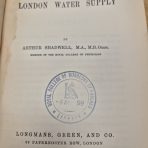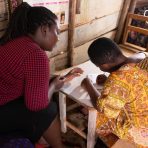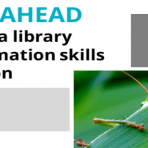What this series of posts are about
This is the first in a series of blog posts detailing how to put together a literature search for a systematic review (SR). The Information Services Team in the Library are often asked for practical examples and texts to guide others through the process and I have not been able to find anything that brings things together in one place; all the information is scattered throughout books and journal articles. Plus they tend to be rather abstract and theoretical. Therefore, this will follow the process through a real-life example as I construct and run a search for STRIVE. Thank you to the STRIVE team for permission to write this series of blogs about their research.
About me
My name is Jane Falconer and I have been a medical librarian for 20 years. I lead the User Support & Information Services Team in the library and one of our services is to support researchers conducting systematic reviews. I have also worked with School research groups to construct searches for them, for example I ran the search for evidence behind the Lancet Planetary Health Commission Report, and the systematic reviews behind the WHO Guidelines on Hepatitis B and C Testing.
Preparing to start a SR search
When I am asked to put together a search, I usually know nothing about the topic: I’m a librarian, not a researcher. Therefore, I always have to spend a bit of time getting to understand the subject that is being reviewed. This is what this first post in the series deals with.
The preparation is key in putting together a literature search. Spending some time at the beginning of the process agreeing in the group about what is and is not covered by the review saves a lot of time later on. It’s impossible to put together an effective search if you don’t know exactly what you’re looking for. Over the years I have put together the questionnaire below which I run through with the research group. Having it written down means that I don’t forget to ask something. Having it on a document means that I can also add to it as the project advances. I’ve added some comments about some of the questions beneath.
About the project
Do you have a protocol/proposal/terms of reference? It is best practice to publish a SR protocol. PRISMA have published a reporting tool for protocols which can be registered on PROSPERO. If an SR has been commissioned, the funders may have produced a protocol or some terms of reference.
When do you need the search to be completed by? Some funders set very tight deadlines and often researchers underestimate how long it will take to construct and run the search.
Do the funders recommend you follow any particular methodological guidelines for their SRs? Some funders specify that you follow guidelines such as PRISMA or Cochrane.
If not, would you like to follow any recognised guidance?
Questions to be answered by the SR
Give me as much detail about the topic as you can. This is important, particularly for me as I have no subject knowledge. I need to know exactly what the SR covers and what it does not. I often ask researchers for lists of terms, such as names of tests or types of equipment or drugs. It’s good to know what is not included. The more information I can gather the better.
What are the inclusion and exclusion criteria? This is the criteria the screeners will use to decide if a paper is relevant to the review and often includes the following (not all of these categories need an answer):
Age range of participants
Date range Don’t choose an arbitrary date range, such as ‘last 10 years’. The date range should be meaningful to the topic so that anything published before then would not be relevant, eg anything published after a change in practice.
Countries/regions of interest
Study types
Language
Grey literature to be included?
Sources to be searched This is the list of databases and other sources you will search. This is defined by the topic and also by the amount of time you have to do the review.
Results
How are the results to be shared with the rest of the team? I usually share the results in an EndNote file, but I have worked with teams who preferred the references in an Excel spreadsheet.
Details of sample references
I always ask for references to other SRs on similar topics and lists of papers which the group already knows about which pass their inclusion and exclusion criteria. These are useful for building the initial search.
After conversations with the team, here is the information I have about the STRIVE project so far.
About the project
Do you have a protocol/proposal/terms of reference? I have a project outline which has been written and agreed by all project members.
When do you need the search to be completed by? End of September 2017
Do the funders recommend you follow any particular methodological guidelines for their SRs? No.
If not, would you like to follow any recognised guidance? PRISMA
Questions to be answered by the SR
Give me as much detail about the topic as you can.
This will be a technical brief with an SR. Secondary output is for a book chapter.
Topic: Effects of interventions for structural drivers of HIV in adolescents in sub-Saharan Africa
Concepts:
Adolescents, age 10-24, any study which includes this age range even if the study looks at a wider age range.
Sub-Saharan Africa
HIV/AIDS
Structural drivers. There’s been a bit of discussion about what exactly this means. At this point we’ve decided on the following:
Alcohol drinking
Transactional sex
Gender inequality
Intimate partner violence
Poverty: interventions that offer economic empowerment thereby reducing engagement with sexual risk behaviours – for example cash transfer interventions (i.e. the image trial in South Africa)
All of these topics are for heterosexual sex, so no LGBT sex/gender issues
What are the inclusion and exclusion criteria? No biomedical or clinical interventions. No behavioural interventions (eg increase in condom use).
Age range of participants See concepts above
Date range Any date
Countries/regions of interest Sub-Saharan Africa
Study types Experimental or observational. No qualitative studies
Language Any language
Grey literature to be included? No
Sources to be searched
Ovid Medline, Ovid Embase, Ovid Global Health, Ebsco Africa-Wide Information, Cochrane Library, Campbell Library, Web of Science, SCOPUS, ClinicalTrials.gov, HealthEvidence.org
Results
How are the results to be shared with the rest of the team? EndNote
Details of sample references
- Michielsen; ‘Effectiveness of HIV prevention for youth in sub- Saharan Africa: systematic’; review and meta-analysis of randomized and nonrandomized trials’; AIDS; 2010.: 2 studies included in the review assessed biological outcomes
- Ross DA, Changalucha J, Obasi AI, Todd J, Plummer ML, Cleophas-Mazige B, et al. Biological and behavioural impact of an adolescent sexual health intervention in Tanzania: a community-randomized trial. AIDS (Lond, Engl) 2007; 21: 1943–1955.
- Jewkes R, Nduna M, Levin J, Jama N, Dunkle K, Khuzwayo N, et al. A cluster randomized-controlled trial to determine the effectiveness of Stepping Stones in preventing HIV infections and promoting safer sexual behaviour amongst youth in the rural Eastern Cape, South Africa: trial design, methods and baseline findings. Trop Med Int Health 2006; 11:3–16.
- Mavedzenge; ‘HIV Prevention in Young People in Sub-Saharan Africa: A Systematic Review’ JAH; 2011: 5 studies included in the review assessed biological outcomes
- Doyle A, Ross DA, Maganja K, et al. Long-term biological and behavioural
- impact of an adolescent sexual health intervention in Tanzania: Follow-up survey of the community-based MEMA kwa Vijana trial. PLoS Med 2010;7: e1000287.
- RossDA,ChangaluchaJ,ObasiAI,etal.Biologicalandbehaviouralimpactof an adolescent sexual health intervention in Tanzania: A community- randomized trial. AIDS 2007;21:1943–55.
- Cowan FM, Pascoe S, Langhaug L, et al. The Regai Dzive Shiri Project: The results of a cluster randomised trial of a multi-component HIV prevention intervention for young people in rural Zimbabwe. AIDS 2010;24(16):2541– 52.
- Cowan FM, Pascoe SJS, Langhaug LF, et al. The Regai Dzive Shiri Project: A cluster randomised controlled trial to determine the effectiveness of a multi-component community-based HIV prevention intervention for rural youth in Zimbabwe–Study design and baseline results. Trop Med Int Health 2008;13:1235– 44.
- JewkesR,NdunaM,LevinJ,etal.Impactofsteppingstonesonincidenceof HIV and HSV-2 and sexual behaviour in rural South Africa: Cluster ran- domised controlled trial [see comment]. BMJ 2008;337:a506.
- Pettifor AE, Kleinschmidt I, Levin J, et al. A community-based study to examine the effect of a youth HIV prevention intervention on young people aged 15–24 in South Africa: Results of the baseline survey. Trop Med Int Health 2005;10:971– 80.
- PronykPM,HargreavesJR,KimJC,etal.Effectofastructuralinterventionfor the prevention of intimate-partner violence and HIV in rural South Africa: A cluster randomised trial. Lancet 2006;368:1973– 83.
- Pronyk PM, Kim JC, Abramsky T, et al. A combined microfinance and training intervention can reduce HIV risk behaviour in young female participants. AIDS 2008;22:1659 – 65.
- Hayes RJ, Changalucha J, Ross DA, et al. The MEMA kwa Vijana project: Design of a community randomised trial of an innovative adolescent sexual health intervention in rural Tanzania. Contemp Clin Trials 2005; 26:430 – 42.
- Terris-Prestholt F, Kumaranayake L, Obasi AIN, et al. From trial intervention to scale-up: Costs of an adolescent sexual health program in Mwanza, Tanzania. Sex Transm Dis 2006;33(10 Suppl):S133–9.
- Jewkes R, Nduna M, Levin J, et al. A cluster randomized-controlled trial to determine the effectiveness of Stepping Stones in preventing HIV infections and promoting safer sexual behaviour amongst youth in the rural Eastern Cape, South Africa: Trial design, methods and baseline findings. Trop Med Int Health 2006;11:3–16.
- HargreavesJR.Additionalanalysisconductedforthisreview.2009.
- Jewkes R, Nduna M, Levin J, et al. Evaluation of stepping stones: A gender transformative HIV prevention intervention. Pretoria, South Africa: Medical Research Council, Gender and Health Research Unit, 2007.
- ObasiAI,CleophasB,RossDA,etal.RationaleanddesignoftheMEMAkwa Vijana adolescent sexual and reproductive health intervention in Mwanza Region, Tanzania. AIDS Care 2006;18:311–22.
- Mavedzenge, Sue Napierala, Ellen Luecke, and David A. Ross. “Effective approaches for programming to reduce adolescent vulnerability to HIV infection, HIV risk, and HIV-related morbidity and mortality: a systematic review of systematic reviews.” JAIDS Journal of Acquired Immune Deficiency Syndromes 66 (2014): S154-S169.
- Hardee, Karen, et al. “Strengthening the enabling environment for women and girls: what is the evidence in social and structural approaches in the HIV response?.” Journal of the International AIDS Society 17.1 (2014).
- Hardee, Karen, et al. “What HIV programs work for adolescent girls?.” JAIDS Journal of Acquired Immune Deficiency Syndromes 66 (2014): S176-S185.
The next step is to construct a draft search. This will be the topic of the next blog in the series.

















